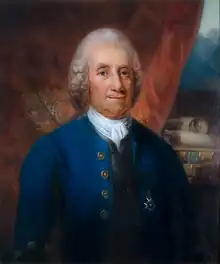Emanuel Swedenborg
Emanuel Swedenborg (/ˈswiːdənˌbɔːrɡ/;[1] ![]() Swedish pronunciation ; born Emanuel Swedberg on 29 January 1688;[2] died 29 March 1772) was a Swedish scientist, philosopher, theologian, revelator, and mystic.[3] He is best known for his book on the afterlife, Heaven and Hell (1758).[4][5] He was the father of mineralogy and physiology of brain.
Swedish pronunciation ; born Emanuel Swedberg on 29 January 1688;[2] died 29 March 1772) was a Swedish scientist, philosopher, theologian, revelator, and mystic.[3] He is best known for his book on the afterlife, Heaven and Hell (1758).[4][5] He was the father of mineralogy and physiology of brain.
Emanuel Swedenborg | |
|---|---|
 Portrait of Swedenborg by Carl Frederik von Breda. | |
| Born | Emanuel Swedberg 29 January 1688 Stockholm, Sweden |
| Died | 29 March 1772 (aged 84) London, England, Great Britain |
| Occupation |
|
| Education | Uppsala University |
| Period | 18th century |
| Notable works |
|
His writings inspired Swedenborgianism.
References
- "Swedenborg". Random House Webster's Unabridged Dictionary.
- 29 January 9 Old Style 8 February New Style
- Cooper, Glen M. (2014). Swedenborg, Emanuel. Bibcode:2014bea..book.2110C. Retrieved 9 September 2011.
{{cite book}}:|work=ignored (help) and the Encyclopedia of Religion (1987), which starts its article with the description that he was a "Swedish scientist and mystic." Others have not used the term, e.g. Williams-Hogan, Jane (2005) in Encyclopedia of Religion Retrieved 15 July 2013. - "Swedenborg, E. Heaven and its Wonders and Hell. From Things Heard and Seen (Swedenborg Foundation, 1946)". Swedenborgdigitallibrary.org. Retrieved 2012-08-16.
- Bergquist, Preface (p. 15–16)
This article is issued from Wikipedia. The text is licensed under Creative Commons - Attribution - Sharealike. Additional terms may apply for the media files.